|
 Gumbo!!! Gumbo!!! 
(gumbo recipe with Creole roux cooking time chart)
This is a hearty, spicy stew with European, African and Native-American influences. Gumbo
is truly Creole in origin, but the Cajuns perfected it over time. As with jambalaya, gumbo is a good way to use
up leftovers - any tasty combination of chopped meats and veggies can go into gumbo (see notes below). I think
this is another recipe my dad got from one of the many restaurants he worked at in New Orleans for so many years.
You can add about ½ to 1½ lbs. (252 to 756 g) of peeled, cleaned shrimp to this recipe, if you like.
As with my jambalaya recipe, this is a version of this dish without seafood in it which is commonly served in and
around New Orleans, Louisiana (I never add any seafood to it because I just don't care for shrimp or crab meat
in my gumbo).
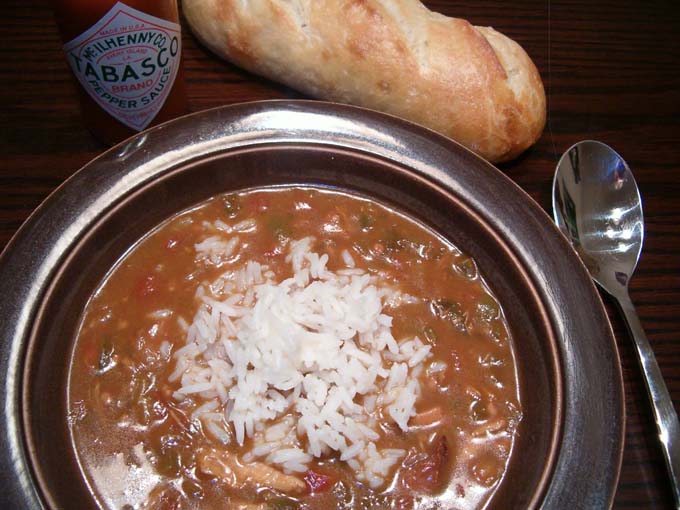
Ingredients:
½ cup (120 ml) oil, butter, lard or bacon drippings
1 cup (226.8 g) white, all-purpose flour
5 - 6 cups (790 - 948 ml) chicken broth and/or water
1 large yellow or white onion, finely chopped
4 - 5 cloves fresh garlic, crushed
1 cup (226.8 g) okra (fresh or frozen - doesn't matter),
sliced (optional - see notes)
1 green, bell pepper, finely diced/chopped
2 ribs celery, finely diced/chopped
12 oz. (360 ml) canned tomatoes, crushed, chopped or diced (with liquid)
½ to 1 cup (113.4 - 226.8 g) cooked chicken meat, diced/shredded
1 - 2 cups (226.8 - 453.6 g) smoked sausage, sliced, and/or ham, chopped
2 bay leaves
4 Tbs. (56.6 g) fresh parsley, chopped
1 Tbs. (14.15 g) each of paprika, Worcestershire sauce and dried, ground thyme
1½ tsp. (7.16 g) each of cayenne (red/hot) pepper and salt
~ hot pepper sauce, to taste ~
~ Cooked,
white rice ~
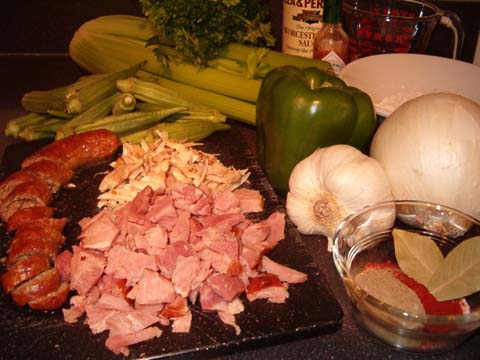
Preparation:
The first and most important step in the traditional, gumbo-cooking process is to heat a fat-and-flour
mixture in which to cook the primary vegetable components. This is called "roux" (pronounced "roo,"
as in "kangaroo"). We have the French to thank for this strange culinary concoction
which makes all the difference in a really good gumbo! The cooking tradition of early French colonists from Europe
is what makes the dish "Creole" in nature; "Cajun" defines the culture of refugees who came
to hide in south-Louisiana woods and swamps after they were exiled from French Canada by the British in the mid-1700s
- their cooking is primarily based on the wild game and ingredients found in their immediate environment. There
are recipes for "roux-less" gumbos out there which rely solely on the the power of okra and/or filé spice powder to thicken them up, but a
truly authentic gumbo has a roux base to it.
The second and final step is adding the rest of the ingredients and simmering until done.
Easy enough, right?
Preparing the Roux:
Mix the fat of your choice and flour together really well and put the mixture in a 4-quart
(3.8-liter) pot on the stove. Traditionally, people put the oil in a pot, heat it up and then gradually add the
flour. But mixing the two ingredients together first in a bowl before placing them in the pot works just fine.
Also, butter, lard and/or bacon fat were at one time used instead of vegetable oil to make a roux. I know that
cooking butter for an extended amount of time turns it brown, and this can skew the appearance of the cooking process
of this step of the recipe. Nearly every modern cook uses some kind of vegetable oil for this dish. I like to use
peanut oil. It's far more healthy than butter or lard, and it adds a more Southern touch to
the dish than using canola or other type of vegetable oil. Also, it has a very high smoking point (so I don't have
to worry about it catching fire at all!).
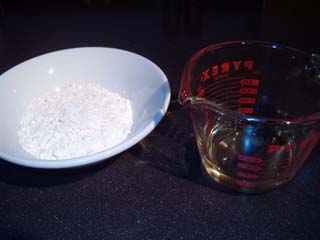 .... ....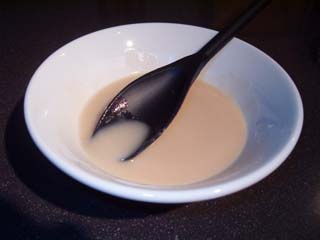
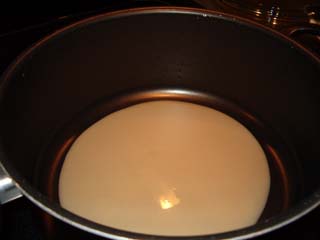
The raw oil/flour mixture has the texture and consistency of thin cake icing.
The most important thing about the most important step to making gumbo is that you do not burn the roux! If you
do, throw it out and start over (the smell will be an obvious give-away if it's burned at all - you will also see
little, black specks appear in it)! If you have never made gumbo roux before, the following instructions will virtually
guarantee that you will not burn your roux.
Turn heat to a low-medium setting (about a 4 on a scale from 1 to 10, 1 being the lowest
temperature and 10 being the highest - I stuck a candy thermometer in it about half of the way through the cooking
process once, and it indicated the heat was just under 325° F., 162.78° C.). Cook it slowly, stirring constantly
with a wooden or metal spoon (a plastic spoon or spatula will melt - I learned that the hard way!). If you keep
it at this temperature while stirring frequently, it shouldn't burn at all. It will start out thick and clumpy
in the pot, but will turn velvety and smooth after about ten minutes. Don't panic if you see an occasional wisp
of smoke rise from the mixture as it heats and develops. What you are basically doing at this point is gently frying
the flour in the oil. You want to cook it until the mixture turns a rich, brown color. This will take lots of time
and patience on your part. You want your gumbo roux to reach a stage where it is cooked at least as dark as peanut
butter, but a dark, chocolate color makes for such a delightfully-hearty style of gumbo!
Creole Roux Cooking Time Chart:
The amount of time it takes to cook a roux to an appropriate level of darkness seems to be
an eternal mystery for tout le mond. But I have studied this cooking process for quite a while
and am happy to present you the following chart as to what you may expect in cooking either a Creole or Cajun style
of roux made with flour and vegetable oil at the temperature described above:
10 minutes: Mixture turns velvety, no distinct odor.
20 minutes: Color starts to change, smells like buttered popcorn!
30 minutes: Color changes to that of butterscotch pudding.
40 minutes: Color looks like peanut butter - roux may be used at this point. It renders a gumbo with a flavor
and consistency comparable to that of typical American brands of commercially-canned gumbo soup. This is also typical
of the roux used to make Creole "city gumbo" (what you'll find served most of the time at restaurants
in New Orleans).
50 minutes: Color turns a caramel-candy hue; smell starts to get intense and nutty (and more Cajun) in character.
60 minutes: Color looks like baked gingerbread.
70 minutes: Color is almost milk chocolate.
80 minutes: Color is a little bit darker than milk chocolate.
1 hour, 30 minutes (90 minutes): Color and consistency is like a light chocolate sauce.
1 hour, 40 minutes (100 minutes): Roux is a nice, dark color, perfect in the eyes of
country-Cajun cooks!
COMPARE:
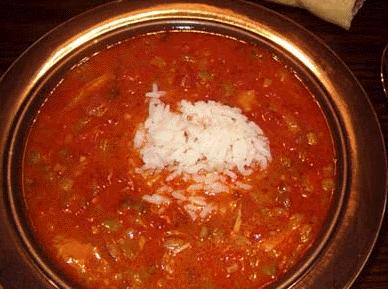 .... ....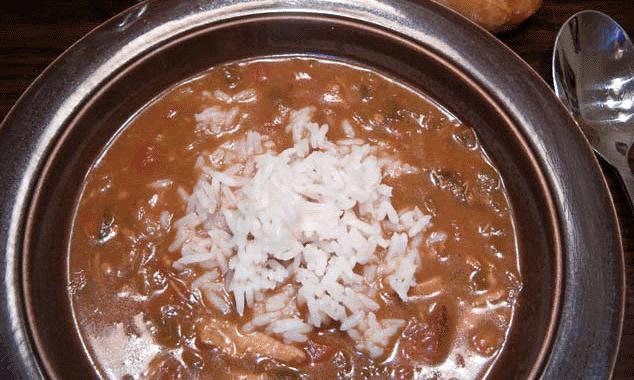
The gumbo on the left had its roux cooked for only about 40 minutes, whereas the roux for
the gumbo on the right was cooked for a full hour and 40 minutes. The roux on the left is
lighter and more red. It is more Creole-style. Though both are very good, the dark, country-style gumbo on the
right is what Cajuns (and I) prefer!
Some out there may say that the temperature I prescribe here is too low. Generally speaking,
if your roux turns peanut-butter brown in an half-hour's time or less, your heat is too high and you risk burning
it. Follow my instructions the first few times you make roux - after a while, you will get a better feel for cooking
it and, eventually, you will become a regular Chef Paul Prudhomme
and be able to "flash" cook a very dark roux in just a few minutes on very high heat ("Cajun napalm"
is what New Orleans' famous chef, Paul Prudhomme, refers to roux as - you have to be careful when cooking roux
because it's red hot and, if you splash any of it on bare skin, it'll stick and burn the heck out of you!).
I've seen Chef Paul on TV heat a cup of oil in a black-iron skillet until it starts smoking, then whisk in the
flour quickly - he gets the oil so very hot that the flour almost instantly turns incredibly dark the moment it
hits the oil! (I can't get it that dark that quickly, but I can get that roux really Cajun dark in about ten to
fifteen minutes now.)
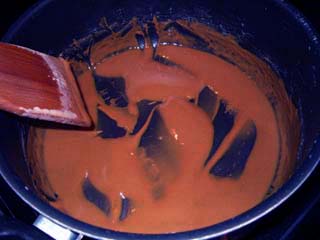
This roux is ready for the vegetables - it has reached a dark
enough color and will do.
The Rest of the Recipe!
Next, add the onion, celery, bell pepper, garlic and, if you're using it, the okra to the
roux. Cook the resulting mixture over the same heat as you cooked the roux, stirring occasionally so as not to
burn it, until the onions are soft and translucent, and the mixture is reduced down. I cover the pot and "sweat"
the vegetables in the roux so that their moisture is rendered in the pot.
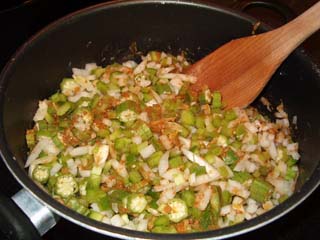
When including the okra, you'll have to cook it, stirring often, until the okra stops "roping"
(that is, until the gooey stringiness of the okra subsides - this can take up to 30 minutes sometimes).
After the okra quits roping, or if you choose to not include any okra, add the tomatoes and
liquid gradually with the chicken broth or water (it tastes best with the broth!). Add the rest of the ingredients
(except the rice); cover and simmer on low heat at least 1 hour (but preferably up to 2½ hours), stirring
occasionally.
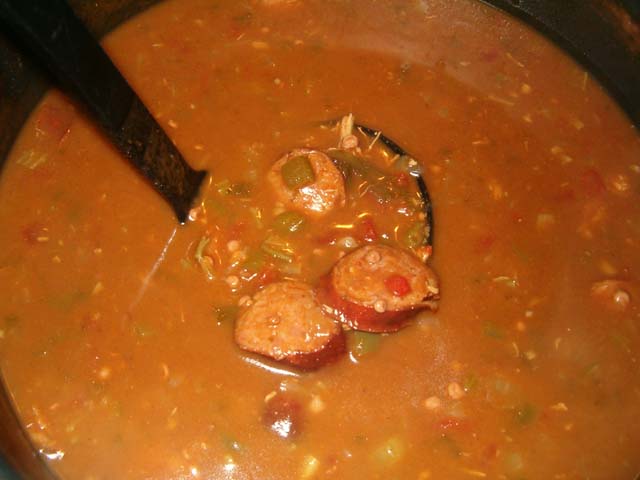
Don't forget to take out the bay leaves!
Serve in wide-rimmed bowls topped with about a half-cup of cooked rice ladled in the center
of it. We also traditionally sprinkle a little filé
powder over the gumbo at the table - it's widely available in most U.S. supermarkets, but I don't know
about overseas markets (it's not absolutely required, so don't worry if you can't find it where you live). Serves
4 - 6.
Notes:
What is not optional with this dish, as with most dishes of the Cajun
and Creole tradition, is what we call the "trinity of Louisiana cooking" - chopped onions, celery and
green, bell pepper.
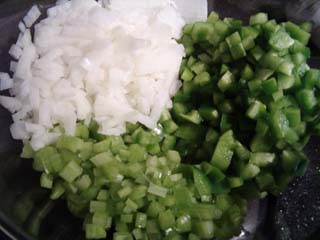
After these core components are sautéed and softened up in your pot, then you may add
whatever other vegetables you like to your gumbo. Have fun and experiment a little!
Okra seems to be optional for nearly every gumbo recipe that I've seen (and I've seen a
lot). But there is evidence out there that the word gumbo is actually a West-African
word meaning okra. Logic would then dictate that okra is not optional in gumbo, but is rather an integral
component quite mandatory to making truly authentic gumbo. More support for the argument that truly authentic gumbo
requires okra comes from the fact that preferred gumbo, made with really dark roux, needs okra as a thickening
agent because cooking the roux until it's really dark causes the roux to lose its thickening power.
Finally, it wouldn't be proper gumbo if you didn't sprinkle a little hot pepper sauce in your
bowl! My absolute favorite is Tabasco brand,
made for over a hundred years now at the company's main location in Avery Island, Louisiana. Use a little or use
a lot, but make sure you use some!
Tip:
Since this recipe is time-consuming, I chop/shred the cooked, left-over meats and chop/slice
all the fresh vegetables the night before making it, storing them in the fridge overnight in containers very tightly
sealed with cling film/wrap. I also measure out all the dry ingredients and store them on the kitchen counter in
a small container wrapped in cling film overnight. That way, all I have to do the next day before cooking the gumbo
roux is measure out the wet ingredients!
|

